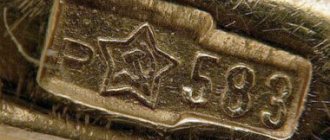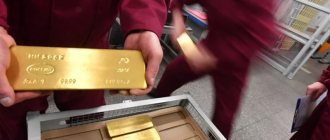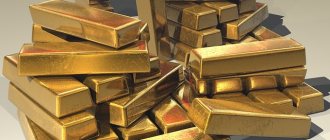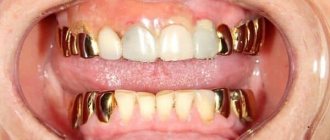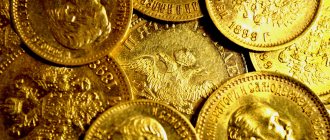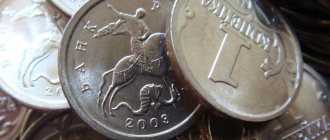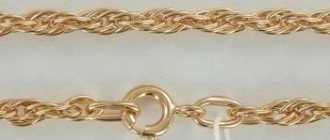After the revolution, the gold reserves of the Russian Empire were plundered, and this brought the country to the brink of ruin. Then gold began to be mined in three ways: OGPU workers knocked it out of the population, Soyuzstroy workers restored the destroyed gold mining, and the famous Dalstroy organized its mining in Kolyma. Gold mined by the hands of prisoners turned out to be the cheapest.
By 1930, Soviet Russia was on the verge of bankruptcy. There was no money for the industrialization proclaimed by Joseph Stalin. The gold reserves were almost completely plundered and wasted. Of the 1,101 tons of pure gold (or 1.8 billion gold rubles) remaining in the Russian Empire at the time of the 1917 coup, the Bolsheviks had 150 tons (200 million gold rubles) left in their bins.
Gold in Tsarist Russia
One of the main factors determining stability in the country is the availability and size of the state gold reserve. By 1923, the USSR had 400 tons of state gold, and by 1928 - 150 tons. For comparison: when Nicholas II ascended the throne, the gold reserves were estimated at 800 million rubles, and by 1987 - at 1095 million. Then a monetary reform was carried out, filling the ruble with gold content.
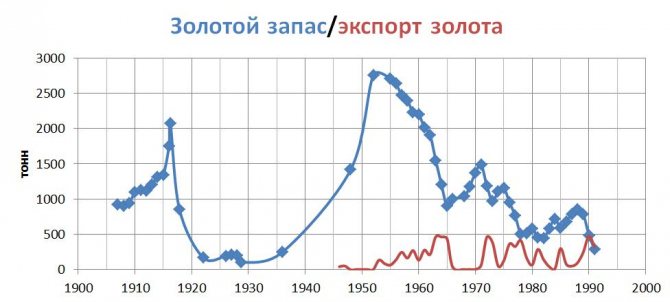
From the beginning of the twentieth century, supplies began to deplete: Russia prepared for the Russo-Japanese War, was defeated in it, and then the revolution occurred. By 1914, gold reserves had been restored. During the First World War and after it, gold was sold (and at dumping prices), pledged to creditors, moving to their territory.
Search and catch up
Simultaneously with the withdrawal of gold from the pockets of the Soviet people, the revival of the gold mining industry began, which collapsed after the coup and did not recover even during the NEP. In 1927, in the USSR, from the Urals to Chukotka, only 20 tons of gold were mined per year. For comparison: in the Transvaal, an African colony of Great Britain, 300 tons of precious metal were mined per year. To extract this valuable resource, the All-Union Gold Mining Joint Stock Company “Soyuzzoloto” was created in 1927, headed by the fiery revolutionary, mechanical engineer Alexander Serebrovsky. The task that was set before him would be considered impossible abroad - to increase gold production to over 300 tons per year and “overtake” the Transvaal. But in the USSR they did not take costs into account. In the same year, Serebrovsky went to the USA to learn from experience in gold mining and hire specialists; its own engineers either left the country or were killed. Search parties were sent to all parts of the USSR, which had to find new gold-bearing areas at any cost. Serebrovsky's fate ended tragically: he was arrested and executed in February 1938. The "gratitude" was generous. In 1930, the Siberian Mining Institute for Gold and Platinum appeared in the USSR, and the Irkutsk Heavy Engineering Plant began producing equipment for the gold mining industry. In the same year, Soyuzzloloto was reorganized into Tsvetmet-Zoloto, and private mining of precious metals in Siberia and the Far East was liquidated. These measures brought results - gold mining in the USSR was restored to pre-revolutionary levels. But this was not enough.
Gold cost
Until 1970, the price of gold was one of the most stable parameters in the world. The US leadership regulated the price at $35 per troy ounce. From 1935 to 1970, America's gold reserves were rapidly declining, so it was decided that the nation's currency would no longer be backed by gold. After this (that is, since 1971), the price of gold began to rise rapidly. After the price surge, the value fell slightly, reaching $330 per ounce in 1985.

The price of gold in the Land of the Soviets was not determined by the world market. How much did a gram of gold cost in the USSR? The price was approximately 50-56 rubles per gram for 583 standard metal. Pure gold was bought at a price of up to 90 rubles per gram. On the black market, a dollar could be bought for 5-6 rubles, so the cost of one gram did not exceed $1.28 until the seventies. Thus, the cost of an ounce of gold in the USSR was a little more than 36 dollars.
Loss of the USSR's gold reserves
V.B. Kuznetsov
— Associate Professor of the Department of Social Sciences and Technologies of NUST MISIS, Ph.D.
History repeats itself twice: once as a tragedy, and once as a farce. This paradox is clearly visible in the history of the loss of the USSR's gold reserves. The accumulated reserves of gold in Russia before the First World War amounted to 1.4 thousand tons [1; p.105]. The hard times of war and revolution reduced it to 150 tons. Stalin increased the gold reserves of the USSR and, despite the difficult Patriotic War of 1941–1945. and the payment of lend-lease to the USA in the amount of 1.5 thousand tons, left behind 2.05 thousand tons of gold [2; With. 450]. The Accounts Chamber of the Russian Federation, which checked the state of the country’s gold treasury in 1996, concluded: “The gold reserve of the country’s State Fund... has been exhausted” [3]. There were no severe open wars or terrible epidemics. Where did the gold go? How did the loss of the gold reserves of the Soviet power, the USSR, occur?
The reign of N.S. Khrushchev's attitude towards gold was exactly the opposite of Stalin's, who after the end of the war stopped selling the precious metal. Since 1953, over the course of 12 years, 2.9 thousand tons of gold were sold on the markets of London and Paris (according to other sources, 3 thousand tons). Most of it falls in 1963–1964, when 1244 tons were sold for grain due to crop failure [4]. In total, for the period 1953–1991. The USSR sold 8.2 thousand tons of “solar metal” on world markets [5; With. 145]. It should be borne in mind that gold was not just “eaten up”, but it was used to buy Western technologies, scarce consumer goods, secure foreign loans, and some went to the jewelry and defense industries. For example, only one modern MIG-23 fighter contains 512 g of gold, 69 g of platinum, 17.183 kg of silver [6; With. 74].
The waste of gold continued, but its production also increased due to the introduction of self-financing, maximum concentration of production and the development of new technologies. For the first time in the world, the technology of sorption leaching of gold, which was developed by Boris Nikolaevich Laskorin, was implemented for the processing of low-grade ores of the largest Muruntau deposit in Central Kyzylkum at the mining and metallurgical plant in Zarafshan. From the beginning of commissioning to the present day, this enterprise and the technology used at it have been a kind of world-class standard, and the production volume has reached 60 tons per year of bank gold bars with a purity of 99.99%. When processing gold ores using sorption technology, the associated release of such valuable metals as silver, selenium, palladium, tungsten, and rhenium was ensured. This method made it possible to radically modernize the processing of gold-containing ores, ensured the production of bank-grade gold directly at the ore processing plant, as well as the possibility of involving in the processing of ores poor in gold content, which were unprofitable using the old technology.
The absolute peak of gold production in the USSR occurred at the end of the 80s of the 20th century, when the Soviet Union reached a production level of at least 300 tons per year. In Central Asia and Armenia, before the end of the USSR, 70–75 tons of gold were mined. In total, from 1918 to 1990, 12.045 tons of precious metal were mined in the USSR [7; With. 24]. Enormous amounts of money were spent on gold mining. Nikolai Vasilyevich Melnikov, a Soviet scientist in the field of mining, academician and Hero of Socialist Labor, speaking at the Polytechnic Museum in the 70s, cited the following figures. The USSR processed 2 billion m3 of rocks per year. Half of them belonged to Glavzoloto [8; With. 577].
In the second half of the 60s, the USSR entered the international gold trading market. Historical materials categorically refute the popular opinion that “Sovzagranbanks showed very low profitability” [9; Int-t]. The USSR played “very smartly” on the world gold market by creating a special “Voschodhandelsbank” with a residence in the GDR (Berlin). In the 70s, the Soviet Union actually controlled the world gold market, although it was in second place in terms of production (200–300 tons per year) after South Africa, which produced more than 700 tons per year. The trick was that the USSR was not a member of the IMF, therefore, he could sell gold for more than $35 per troy ounce. Countries included in the IMF did not have the right to raise the price above the official one. Before perestroika, gold was extremely liquid money in the USSR for solving difficulties, incl. and food, and to improve the standard of living of the entire population.
Do not forget that the USSR was a socialist state. Yuri Yuryevich Karnaukh, director of this bank, recalled, referring to the words of the Chairman of the Board of the State Bank of the USSR V.S. Alkhimov that out of five loaves of bread in the USSR, three were paid for by Voskhod. [10; Int-t]. Skillfully playing on the gold market, the USSR sold only 200–300 tons per year, but influenced the entire world gold market, which at that time amounted to 35 thousand tons. The price of gold in the mid-80s reached $800–850/ oz., rising 23 times in 10 years. The elegance and virtuosity of Soviet operations in the gold market have been repeatedly noted by many Western business publications. For his profitable services to the Fatherland, Yu.Yu. Karnaukh was awarded the Order of the Red Banner of Labor in 1974, and in 1980 the Order of Friendship of Peoples for purchasing “at a very good price” medal gold for the 1980 Olympic Games.
According to some data, during his work in Zurich, Yu.Yu. Karnaukh and the bank he heads earned about $4 billion for the country of the Soviets [11; Int-t]. Moreover, his salary was 2 thousand Swiss francs. The Swiss cleaning lady at his bank received the same amount. In our opinion, the most fantastic method of transporting gold bars to Switzerland was chosen. “We transported it (the gold) in regular Soviet passenger planes. Seven tons of gold (in standard 12.5 kg bars) were evenly laid out under the passenger seats. For many years people flew to Zurich and did not know that they were literally sitting on gold” [12; Int-t]. Gold went to partners and buyers - the so-called. "grosbanks". Each of them had its own gold smelting and refining enterprises. Our partners erased hammers and sickles from the ingots and put their marks on them. Why? On the international market, the so-called unit is accepted as a unit. "good London bullion." It must contain between 350 and 430 troy ounces of gold (about 12.5 kg), have a metal purity of at least 995 parts per thousand, and the number and company stamp of one of the 49 gold smelters in the world. The state symbols of the USSR (the hammer and sickle) were removed because the Arab sheikhs, the main buyers of gold, were “allergic” to our symbols, as Yu.Yu explains. Karnaukh.
In the mid-80s, Voskhod Bank was hit by a series of international inspections and persecutions. Yuri Yuryevich explained the failures of the bank by the intervention of the CIA, which brought their people into the bank and “drowned” it. Albert Makeev, deputy director of the bank, sensing something was wrong, began an investigation, but was soon found dead in Zurich. “His body was returned to the USSR without many internal organs, so that the cause of death could not be established” [13; Int-t]. The Cold War continued. For the United States, the profitable and successful operation of the bank was like a bone in the throat. And if you consider that the United States put pressure on the Saudi family and dropped the price of oil, then all this worsened the economic situation and accelerated the destruction of the USSR. At the end of the 80s there was no time for trading gold.
During the years of perestroika in 1985–1987. The gold reserves of the USSR were at the level of 600–700 tons. It is necessary to point out that there are other data. But the most accurate figure is given by Nikolai Ivanovich Ryzhkov, Chairman of the Council of Ministers of the USSR, in an interview with V.I. Kalugin, editor of the magazine “Gold of Russia”. “When I headed the government (1985), the gold reserve was 500 tons. This is what was in bullion. We did not count what was in the State Repository and the Diamond Fund” [14; With. 73]. In general, the era of perestroika and especially the 90s were catastrophic for the gold industry. The export of gold abroad grew, and production fell sharply after the collapse of the USSR. Evgeniy Matveevich Bychkov, head of the USSR Gokhran in 1987–1990, provided data on the extraction of the precious metal. In 1991, 137.7 tons were mined, and in 1996 only 113.3 tons. Let us recall once again that in 1989 the USSR produced 300 tons of gold [15; With. 302].
Why has production fallen so sharply? Russia did not have its own management of the gold industry until the Goskomdragmet of the Russian Federation was created in 1993. However, the main reason was the denationalization of the gold industry. Privatization of the gold mining industry proceeded rapidly. Instead of 12 powerful associations of the USSR period, by 1993 more than 700 were already functioning. Gold production in some companies barely reached 20 kg per year. In the Krasnoyarsk Territory, before privatization, a gold mining enterprise produced 13–15 tons per year, and “now only 320 kg or less” [16]. But gold production requires maximum concentration and centralization due to its extreme labor intensity. This was the case under Stalin and in the USSR. Then production grew at a colossal pace. The well-known economist V. Katasonov notes that in general more than one third of gold mining enterprises in Russia are controlled by foreigners. Including the world's best gold processing and purification complex in Uzbekistan, built using the unique technology of B.N. Laskorina, which was already mentioned in the article. The enterprise with its fantastic technologies was lost and now the USA and American companies are there [17; With. 74].
Despite the decrease in the amount of gold entering the state treasury, its sales abroad have increased sharply. For the period 1984–1991 1565.3 tons of gold were exported from the USSR. In 1990 alone, 474.6 tons were exported abroad - a record amount in the entire history of the country [18; With. 263]. Such large-scale supplies were intended to compensate for the loss of foreign exchange income of the USSR as a result of the fall in prices on the world market in 1986, as well as to eliminate the man-made disaster at the Chernobyl nuclear power plant. As a result, the gold reserves fell almost to the maximum value of 240 tons [19; With. 110]. Evgeny Denisov believes that from the USSR only from 1989 to 1991. More than 2.3 thousand tons of gold were “distilled” abroad. According to his data, over the last three years of perestroika, $30 billion was taken out of the country, and actually stolen [20; Int-t]. And the country was sliding into the abyss, the people were impoverished and even the simplest products disappeared from store shelves.
It is necessary to point out the fact that during this period, when Russia was actively selling gold reserves on foreign markets, the price of gold was artificially collapsed as a result of the global IMF scam. Through coordinated actions of global investment banks, gold mining companies and central banks of the world, the price of gold was artificially low and fell from 450 to 250 dollars per ounce. [21; With. 156]. Pavel Lunyashin calls the “fabulously low” price at which gold was sold in 1989–1991. — $7 per 1 g at world prices of $12–16 [22]. The conspiracy was drawn up against Russia, which lost many billions on the sale of gold. The export of gold was carried out with serious violations and in conditions of the strictest secrecy (from government authorities), essentially representing criminal operations. An example of a typical plot related to the abuse of Gokhran funds is the “Golden Ada” case, when in 1993 a unique collection of diamonds and more than 5 tons of gold coins were taken out of Russia to the American “Golden Ada” campaign, which was created by “immigrants” » from the USSR [23; With. 126]. They hoped to get a loan against these valuables. Failed to get a loan. Gold and diamonds became the key to elementary predatory greed. A criminal case was opened against Andrei Kozlenok, the head of Golden Hell. The Chairman of the Government V.S. was questioned as witnesses. Chernomyrdin and E.T. Gaidar.
It was never possible to return the valuables to their homeland. Examples of many other criminal schemes are similar. The fate of the gold exported in 1991 is unknown, it was called “party gold”, there are legends about it and a lot of articles have been published. This gold, sold in 1990–1991, according to the economist Professor V. Katasonov, is 540 tons in weight equivalent, plus 250 tons as collateral for Western loans [23; With. 250]. Today, many years later, it is obvious that the story about the CPSU gold was invented to cover up and distract public opinion from the real essence of the problem. And most importantly, for the liquidation of the CPSU and, consequently, the USSR. At the beginning of 1995, Russia’s gold reserves, as stated by the leaders of Roskomdragmet, amounted to 321.9 tons. But already on October 1 of the same year, it “weighed” 115 tons, Vladimir Petrov, the First Deputy Minister of Finance of Russia, officially stated, speaking in State Duma [24; With. 73]. Chairman of the Security Committee Viktor Ilyukhin immediately made a statement that Russia “has completely lost its gold reserves,” while 8.2 thousand tons of “despicable metal” are stored in the basements of Fort Knox (US Treasury storage facility) [25; With. 73]. Where did the gold go? Gold and diamonds were used both to replenish the budget and for unscheduled work: the repair of the White House, which was shot down by tanks, the restoration of the Chechen Republic after the war, the election of the President of Russia. According to open press data, at least $1 billion of gold and jewelry raw materials were sold annually [26].
In the early 90s, the party of the former USSR (USA) began to look for gold. The initiator of the search was the Chairman of the Government of the Russian Federation, Yegor Timurovich Gaidar. The firm was paid $1.5 million. After 90 days, according to the contract, it presented the report personally to Gaidar, but “the report disappeared without a trace” [27]. The Government Office and the Presidential Administration, in response to a corresponding request, claim that there were and are no documents about the company, and no one has approached it with requests. Journalist Yu. Shchekochikhin, who published an article and photocopies of documents in 2002, unexpectedly dies in 2003. The circle finally closed after the death of the famous writer and journalist Yu. Semenov, who more than once published materials on the “golden question” in the newspaper “Top Secret” .
The veil of secrecy, which was securely closed for many years, was slightly lifted by Georgy Gavrilovich Matyukhin, the first Chairman of the Central Bank of the Russian Federation in 1991. He recalls in his memoirs that when he began working with VEB (Vnesheconombank) in 1991, he discovered the loss of 12 billion dollars of foreign exchange reserves and 300 tons of gold. “In Basel (Bank of International Reserves, the club and center of the planet’s monetary world) I raised the question of finding the missing money. They promised to find me what was missing. Information about my search reached the very top. And this was the reason for my quick withdrawal. Gaidar, not knowing about my search, also hired a company, but stopped in time. Later I found out how the gold and money left in the fall of 1991. They left the country on a cruise ship along the Volga, then along the Black Sea.” Yu.Yu. Karnaukh, this experienced Soviet “gold” banker, carefully and subtly concluded that with this gold the new government bought off the old government. [28; Int-t].
Indirectly, but quite clearly, it is possible to track the end point of this route. At a secret meeting of the US Joint Chiefs of Staff on October 24, 1995, President Bill Clinton took stock of relations with Russia in recent years. In particular, he said that “over the past four years, we and our allies have received strategic raw materials worth $15 billion, hundreds of tons of gold, precious stones, etc. At existing interest rates, over 20 thousand tons of copper were transferred to us for a negligible amount , almost 50 thousand tons of aluminum, 2 thousand tons of cesium, beryllium and strontium...” [29; Int-t].
It’s sad to read the list of losses of the great empire - the USSR, how our country was plundered in the 90s.
After the collapse of the USSR, the gold mining industry was virtually left to the mercy of the market. There was no long-term strategy for the development of the industry, which would make it possible to specifically define government priorities and national interests in the gold sector. The goal of this strategy should be for Russia to restore its lost positions in the world gold market, especially since Russia is a gold-mining state with rich reserves, and it must realize this advantage with maximum effect. In terms of its gold reserves, Russia ranks second in the world, especially in its huge deposits of ore gold. Placer reserves have long been worked out and depleted, and 73% of ore deposits are still waiting in the wings. There were periods in Russia's past when the state pursued a very effective and well-thought-out gold policy. It doesn’t matter - the financial reforms of Count Witte or Stalin’s industrialization. Since 2017, gold mining by individual entrepreneurs has been allowed in Russia. By the way, from 1932 to 1941 it was almost the same under Stalin, when production increased 5 times. Then anyone (without a criminal record) could mine gold. Private miners had benefits, received orders, special food, and rest homes. This was a golden time for miners, whose number reached 300 thousand people. Since 1997, commercial banks have been given the right to carry out export-import transactions with gold.
Over the past decade, Russia has been intensively increasing its gold and foreign exchange reserves. According to open press information, over the last 4 years alone, Gokhran has been buying at least 200 tons of gold every year. At the end of 2021, gold reserves increased to 2113 tons [30]. Gold mining is also growing. In 2021, it amounted to 314.42 tons. Of this gold, purchases of the Central Bank, according to open press data, reached 274.3 tons [31]. I would like to believe that Russia is concentrating.
The overwhelming majority of Russia's foreign exchange reserves (95%) are placed in short-term and medium-term treasury securities of the issuing states of the corresponding types of currencies. Such placement conditions ensure the liquidity of investments and guarantee high reliability. There is, however, a third “advantage” that people don’t like to mention again. The currency and economy of the custodian state are strengthened.
Civilizations change, empires arise and fall, people are born and die, and gold continues to be mined with constant passion and a sense of reverence for the “shards of the sun” on earth.
Gold attracts humanity with its mysterious beauty, for the sake of it people endure hardships, make discoveries in the name of the glory of the state or in the name of their own well-being. The story of gold continues. But that is another topic. Published in the magazine “Gold and Technologies”, No. 4 (46) / December 2019 1. Sidorov A.P. Financial policy of Russia during the First World War. Publishing house of the USSR Academy of Sciences. M.: 1960. 578 p. 2. Sirotkin V.A. Foreign gold of Russia. M.: Olmapress. 2000. 463 p. 3. Snegirev Yu. Wallet for a rainy day. // News. 15.5.1999 4. Krotov N. Chasing the yellow devil. // M.K. 6.6.2007 5. Andrianov V. Gold and foreign exchange reserves of Russia. // Society and economics. 2003. No. 9. 265 p. 6. Chernyak A. How Russia’s gold reserves dried up. // Belarusian thought. 1996. No. 8. pp. 73–98. 7. Katasonov V. Gold in the economics and politics of Russia. M.: Ankil, 2009. 270 p. 8. Rudakov V.V., Smirnov A.P. Gold of Russia. M.: Krugozor Nauka. 2006. 710 p. 9. Khandruev A. Who released the legendary gold of the CPSU and where? [Electronic resource] // Version No. 24. (Date of access: 08/28/2019). 10. About how Yu. Karnaukh traded gold in the USSR [Electronic resource] // Signalrp. Main news. Part 2. (Date of circulation: 08/28/2019) 11. Krotov N. History of Soviet and Russian banks abroad. Memories. Documentation. M.: Economic Chronicle. 2007. T. 1. 650 p. 12. Ibid. 13. Ibid. 14. Chernyak A. How Russia’s gold reserves dried up. // Belarusian thought. 1996. No. 8. pp. 73–98. 15. Sapogovskaya L.V. History of gold mining in the USSR // Sat. Economic history. Yearbook. 2003. ROSSPEN.: 2004. pp. 3–8. 16. Gold mining in the Krasnoyarsk region today. // Independent newspaper. November 30, 1999 17. Chernyak A. How Russia’s gold reserves dried up. // Belarusian thought. 1996. No. 8. pp. 73–79. 18. Andrianov V.D. Gold and gold and foreign exchange reserves of Russia. // Society and economics. 2003. No. 9. 265 p. 19. Katasonov V. Gold in the economics and politics of Russia. M.: Ankil, 2009. 270 p. 20. Denisov E. How the USSR was plundered. [Electronic resource] Ry AN (Date of circulation 08/28/2019). 21. Andrianov V.D. Gold and gold and foreign exchange reserves of Russia. // Society and economics. 2003. No. 9. 265 p. 22. Lunyashin P. “Gold and technology.” 2021. No. 2(40). 23. Katasonov V. Gold in the economics and politics of Russia. M.: Ankil. 2009. 270 p. 24. Chernyak A. How Russia’s gold reserves dried up. // Belarusian thought. 1996. No. 8. pp. 73–79. 25. Ibid. 26. Snegirev Yu. Wallet for a rainy day. // News. November 3, 2001 27. Shleinov R. Search so as not to find. // New Newspaper. April 22–24, 2002 28. Matyukhin G.G. I stormed the Bank of Russia [Electronic resource]. Bankir RU (Date of circulation: 08/28/2019). 29. Morozov M. How to destroy Russia. Tribune. 08/21/2008 Or: The author’s program “Moment of Truth” by A. Karaulov. Or: Russian folk line - internet. 30. Gazette. March 7, 2021 31. View [Electronic resource]. (Date of application: 08/28/2019).
The myth of party gold
Party gold refers to the hypothetical gold and currency funds of the CPSU, which allegedly disappeared after the collapse of the USSR and have not yet been found. The myth about the existence of the untold wealth of the leaders of the Union became popular in the media in the early nineties. The reasons for the increased interest in this issue was the participation of Communist Party leaders in privatization, while the majority of the country's population was below the poverty line.
The first publication devoted to this issue is the book “Corrupt Russia” by Andrei Konstantinov. The author gives the following possible scheme for the receipt of funds into the party’s “black treasury” using the example of a scheme that was revealed during an inspection of the Lenrybkholodflot party organization.
Thus, prosecutors established that high earnings resulted in significant contributions to the party treasury. In this case, double statements were used, and most of the funds were sent to higher authorities, that is, first to the regional committee, and then to Moscow. The incident was resolved with the participation of senior party officials.
Where did the USSR gold go? Many public and political figures dealt with this issue: Russian writer Alexander Bushkov, academician of the Russian Academy of Sciences Gennady Osipov, international observer Leonid Mlechin, chairman of the KGB of the USSR and close associate of Yuri Andropov Vladimir Kryuchkov, dissident historian Mikhail Geller and others. Experts have not come to a clear conclusion about the existence of party money and its location.
Stalin's gold
The royal gold treasury was wasted in just a few years. Even before the Bolsheviks came to power, more than 640 million gold rubles were exported abroad by the Tsarist and Provisional governments to pay for war loans. In the ups and downs of the Civil War, with the participation of both whites and reds, they spent, stole and lost gold worth about 240 million gold rubles.
But the “tsarist” gold reserves melted especially quickly in the first years of Soviet power. The gold was used to pay indemnities for the separate Brest-Litovsk Peace Treaty with Germany, which allowed Soviet Russia to withdraw from the First World War, and for “gifts” under the peace treaties of the 1920s to its neighbors - the Baltic states, Poland, and Turkey. Huge amounts of money were spent in the 1920s to foment world revolution and create a Soviet spy network in the West. In addition, tons of gold and jewelry expropriated from the “property classes” were used to cover the Soviet foreign trade deficit. With the complete collapse of the economy, the lack of exports and income from them, as well as difficulties in obtaining loans in the capitalist West, Soviet Russia had to pay for the import of vital goods with national gold reserves.
In 1925, a US Senate commission investigated the issue of Soviet exports of precious metals to the West. According to her data, in 1920–1922 the Bolsheviks sold more than 500 tons of pure gold abroad! The realism of this assessment was confirmed both by secret documents of the Soviet government and by the meager cash in the vaults of the State Bank of the USSR. According to the “Report on the Gold Fund,” compiled by a government commission that, on Lenin’s instructions, examined the financial situation of the country, as of February 1, 1922, the Soviet state had gold worth only 217.9 million gold rubles, and of these funds it was necessary to allocate 103 million gold rubles to pay off the national debt.
By the end of the 1920s the situation had not improved. Russia's gold reserves had to be created anew.
In 1927, forced industrialization began in the USSR. Stalin's calculation that foreign exchange earnings from the export of agricultural products, food and raw materials would finance the country's industrial development did not come true: in the context of the global crisis that broke out in 1929 and the protracted depression in the West, prices for agricultural products fell hopelessly. In 1931–1933—the decisive stage of Soviet industrialization—real export earnings annually were 600–700 million gold rubles less than expected before the crisis. The USSR sold grain at half or even a third of the pre-crisis world price, while millions of its own peasants who grew this grain were dying of hunger.
Stalin did not think about retreat. Having started industrialization with an empty wallet, the USSR took money from the West, Germany being the main creditor. The country's external debt since the fall of 1926 increased by the end of 1931 from 420.3 million to 1.4 billion gold rubles. To pay off this debt, it was necessary to sell to the West not only grain, timber and oil, but also tons of gold! The country's meager gold and foreign exchange reserves were melting before our eyes. According to the State Bank of the USSR, from October 1, 1927 to November 1, 1928, more than 120 tons of pure gold were exported abroad. In fact, this meant that all the free gold and foreign exchange reserves of the country were used, plus all the gold industrially mined in that financial year. It was in 1928 that Stalin began selling off the country's museum collections. Artistic exports resulted in the loss for Russia of masterpieces from the Hermitage, the palaces of the Russian aristocracy and private collections. But the costs of the industrial breakthrough were astronomical, and the export of works of art could provide only a very small part of them. The largest “deal of the century” with US Treasury Secretary Andrew Mellon, as a result of which the Hermitage lost 21 masterpieces of painting, brought Stalin’s leadership only about 13 million gold rubles (the equivalent of less than 10 tons of gold).
Gold from the State Bank was delivered by steamship to Riga, and from there by land to Berlin, to the Reichsbank. In the early 1930s, gold cargo from the USSR arrived in Riga every two weeks. According to the American Embassy in Latvia, which closely monitored Soviet gold exports, from 1931 to the end of April 1934, gold worth more than 360 million gold rubles (more than 260 tons) was exported from the USSR through Riga. However, it was impossible to solve the problem of external debt and financing of industrialization using the gold and foreign exchange reserves available in the State Bank.
What to do? At the turn of the 1920s and 1930s, the country's leadership was gripped by a gold rush.
Stalin respected America's economic achievements. According to eyewitness accounts, he read Bret Harte and was inspired by the gold rush in California in the mid-19th century. But the Soviet gold rush was strikingly different from free Californian entrepreneurship.
There it was the business and risk of free people who wanted to get rich. The discovery of gold in California breathed life into the region, giving impetus to the development of agriculture and industry in the Western United States. California's gold contributed to the victory of the industrial North over the slave-owning South.
In the Soviet Union, the gold rush of the turn of the 1920s and 1930s was a state-owned enterprise whose purpose was to finance industrialization and create a national gold reserve. The methods by which it was carried out gave rise to mass famine, the prisoners' Gulag, the plunder of church property, national museums and libraries, as well as personal savings and family heirlooms of their own citizens.
When extracting gold and currency, Stalin did not disdain anything. At the end of the 1920s, the criminal investigation department and the police transferred all cases of “currency traders” and “value holders” to the Economic Directorate of the OGPU. Under the slogan of fighting currency speculation, “scrofulous campaigns” followed one after another—the confiscation of currency and valuables from the population, including household items. Persuasion, deception and terror were used. Nikanor Ivanovich’s dream from Bulgakov’s “The Master and Margarita” about the theatrical forced surrender of currency is one of the echoes of the “scrofula” of those years. The torture concert for currency traders was not the writer’s idle fantasy. In the 1920s, the OGPU convinced Jewish Nepmen to hand over their valuables using native melodies performed by a guest musician.
But jokes aside, the OGPU also had frankly bloody methods. For example, the “dollar steam room” or “golden cells”: “currency traders” were kept in prison until they told where the valuables were hidden, or relatives from abroad sent a ransom - “salvation money”. Demonstration executions of “currency and gold concealers”, sanctioned by the Politburo, were also in the arsenal of OGPU methods.
In 1930 alone, the OGPU handed over to the State Bank valuables worth more than 10 million gold rubles (the equivalent of almost 8 tons of pure gold). In May 1932, the deputy chairman of the OGPU, Yagoda, reported to Stalin that the OGPU cash desk contained valuables worth 2.4 million gold rubles and that, together with the valuables that “were previously handed over to the State Bank,” the OGPU had extracted 15.1 million gold rubles (almost 12 tons purity in gold equivalent).
The methods of the OGPU at the very least made it possible to obtain large treasures and savings, but there were values of a different kind in the country. They were not hidden in hiding places or underground, ventilation pipes or mattresses. For everyone to see, they glittered with a wedding ring on their finger, an earring in their earlobe, a gold cross on their body, a silver spoon in the chest of drawers. Multiplied by the country's 160 million population, these simple things, scattered among boxes and sideboards, could turn into enormous wealth. As the gold reserves of the State Bank depleted and the foreign exchange appetites of industrialization grew, the leadership of the USSR grew stronger in its desire to take these savings from the population. There was also a way. During the hungry years of the first five-year plans, the population’s valuables were bought up by the stores of Torgsin, the “All-Union Association for Trade with Foreigners on the Territory of the USSR.”
Torgsin opened in July 1930, but at first it served only foreign tourists and sailors in Soviet ports. The depletion of gold and foreign exchange reserves and the needs of industrialization forced the Stalinist leadership in 1931 - the apogee of the madness of industrial imports - to open the doors of torgsin to Soviet citizens. In exchange for cash currency, royal gold coinage, and then household gold, silver and precious stones, Soviet people received Torgsin's money, which they used to pay in his stores. With the admission of the hungry Soviet consumer to Torgsin, the sleepy life of elite stores ended. Torgsin stores shining with mirrors in large cities and unsightly little shops in godforsaken villages—Torgsin’s network has covered the entire country.
The terrible year 1933 was the sad triumph of Torgsin. Happy was the one who had something to hand over to Torgsin. In 1933, people brought 45 tons of pure gold and almost 2 tons of silver to Torgsin. With these funds they purchased, according to incomplete data, 235,000 tons of flour, 65,000 tons of cereals and rice, 25,000 tons of sugar. In 1933, food products accounted for 80% of all goods sold in Torgsin, with cheap rye flour accounting for almost half of all sales. Those dying of hunger exchanged their meager savings for bread. Mirrored delicatessen stores were lost among Torgsinov's flour warehouses and sackcloth bags of flour. Torgsin's price analysis shows that during the famine, the Soviet state sold food to its citizens on average three times more expensive than abroad.
During its short existence (1931 - February 1936), Torgsin produced 287.3 million gold rubles for the needs of industrialization - the equivalent of 222 tons of pure gold. This was enough to pay for the import of industrial equipment for ten giants of Soviet industry - Magnitogorsk, Kuznetsk, DneproGES, Stalingrad Tractor Plant and other enterprises. The savings of Soviet citizens amounted to more than 70% of Torgsinov's purchases. The name Torgsin - trade with foreigners - is false. It would be more honest to call this enterprise “Torgsovlyud”, i.e. trade with Soviet people.
The savings of Soviet citizens are a finite value. The OGPU, with the help of violence, and Torgsin, with the help of famine, almost completely emptied the people's money-boxes. But there was gold in the depths of the earth.
On the eve of the First World War, in 1913, 60.8 tons of gold were mined in Russia. The industry was in the hands of foreigners, and manual labor predominated in it. In the Civil War, the Bolsheviks defended all the known gold-bearing lands of the Russian Empire, but wars and revolutions destroyed the gold mining industry. Under the NEP, gold mining began to revive through private miners and foreign concessionaires. It is paradoxical that, given the state’s dire need for gold, Soviet leaders treated the gold mining industry as a tertiary industry. They spent a lot of gold, but cared little about its extraction, living like temporary workers through confiscations and buying up valuables.
Stalin paid attention to gold mining only with the beginning of the industrial breakthrough. At the end of 1927, he summoned the old Bolshevik Alexander Pavlovich Serebrovsky, who by that time had already distinguished himself in the restoration of the oil industry, and appointed him chairman of the newly created Soyuzzoloto. In Soviet Russia that year, only about 20 tons of pure gold were mined, but Stalin set the task boldly in a Bolshevik way: to catch up and overtake Transvaal, the world leader, which produced more than 300 tons of pure gold per year!
As a professor at the Moscow Mining Academy, Serebrovsky twice traveled to the United States to learn from American experience. He studied technologies and equipment in the mines of Alaska, Colorado, California, Nevada, South Dakota, Arizona, Utah, bank financing of gold mining in Boston and Washington, and the operation of factories in Detroit, Baltimore, Philadelphia and St. Louis. He recruited American engineers to work in the USSR. Due to health problems, the second trip ended in the hospital. But the selfless work of Serebrovsky and his associates brought results. The flow of gold into the State Bank vaults began to increase. Since 1932, the “civilian” gold mining, which was under the authority of the People’s Commissariat of Heavy Industry, was supplemented by Dalstroy, the gold mining of Kolyma prisoners.
The astronomical figures of the plans were not fulfilled, but gold production in the USSR grew steadily from year to year. The fate of Serebrovsky was sad. He was appointed to the post of People's Commissar, and the next day he was arrested. They carried him out on a stretcher straight from the hospital, where Serebrovsky was treating his health, which had been undermined in the service of the Soviet state. In February 1938 he was shot. But the job was done - the gold mining industry was created in the USSR.
In the second half of the 1930s, the USSR took second place in the world in gold mining, overtaking the United States and Canada and second, albeit by a huge margin, only to South Africa, whose annual production approached the 400-ton mark by the end of the decade. The West was frightened by the loud statements of the Soviet leaders and seriously feared that the USSR would flood the world market with cheap gold.
In the pre-war period (1932–1941), the prisoner's Dalstroy brought Stalin's leadership almost 400 tons of pure gold. Non-GULAG “civilian” gold mining for the period 1927/28–1935 produced another 300 tons. There is no data on the work of “civilian” free gold mining in the second half of the 1930s, but if we assume that development proceeded at least at the same pace as and in the mid-1930s (an annual increase of 15 tons on average), then its pre-war contribution to the achievement of monetary independence of the USSR will increase by another 800 tons. Gold in the USSR continued to be mined both during the war and after it. In the last years of Stalin's life, annual gold production in the USSR exceeded the 100-ton mark.
Having created a gold mining industry, the country overcame the gold and foreign exchange crisis. As a result of victory in World War II, the USSR's gold reserves were replenished through confiscations and reparations. After the war, Stalin stopped selling gold abroad. Stalin's moneybox was opened by Khrushchev, who spent gold mainly on the purchase of grain. Brezhnev also actively spent “Stalin’s gold”, mainly to support third world countries. By the end of Brezhnev's reign, Stalin's gold reserves had dwindled by more than a thousand tons. Under Gorbachev, the process of liquidating Stalin's treasury was completed. In October 1991, Grigory Yavlinsky, who was responsible for negotiating economic assistance with the G7, announced that the country's gold reserves had dropped to approximately 240 tons. The USSR's main adversary in the Cold War, the United States, had by that time accumulated more than 8,000 tons.
By stockpiling gold in every possible, and often criminal and reckless way, Stalin accumulated funds that ensured the influence of the USSR in the world for several decades to come. However, this was a disservice to Russia. Stalin's gold reserves extended the life of the inefficient planned economy. The Soviet era ended along with Stalin's golden treasury. The leaders of the new post-Soviet Russia had to create the national gold and foreign exchange reserves anew.
The author is Doctor of Historical Sciences, Professor of Russian History at the University of South Carolina (USA), author of the book “Gold for Industrialization: TORGSIN”
Three suicides in a row
At the end of August 1991, Nikolai Kruchina, the manager of the CPSU, fell out of a window. The party's chief treasurer was considered close to Mikhail Gorbachev. More than a month later, Georgy Pavlov, Brezhnev’s comrade-in-arms and Nikolai Kruchina’s predecessor in office, died in a similar manner. He held this position for eighteen years. Of course, these two people were aware of the party's affairs.
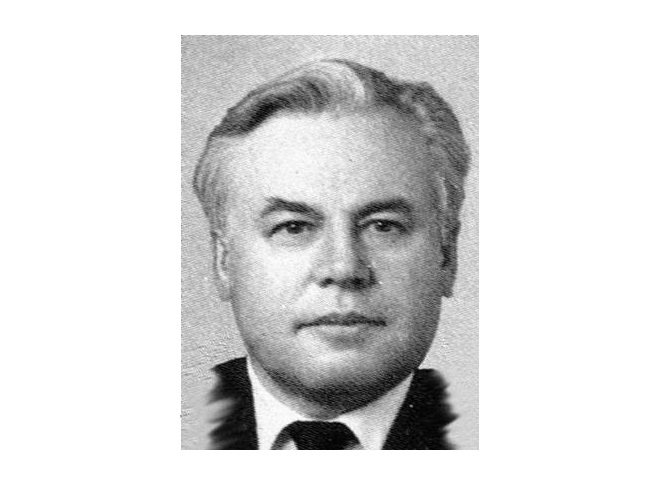
A few days later, Dmitry Lisovolik, the head of the Central Committee department that dealt with the American sector, fell out of the window of his own apartment. This department carried out communications with foreign parties. The death of three officials at once, who were well aware of the financial activities of the Communist Party, gave rise to the legend of the existence of USSR gold, which disappeared in the last year of the existence of the state of peasants and workers.
Was there gold?
The Communist Party ruled the state for 74 years. At first it was an elite organization consisting of a few thousand chosen ones, but towards the end of its existence the Communist Party grew thousands of times. In 1990, the number of officials was almost 20 million people. All of them regularly paid party dues, which made up the treasury of the CPSU.
Some of the funds went into the salary fund for nomenklatura workers, but how much money was actually in the treasury and how was it spent? This was known only to a select few, among whom were Dmitry Lisovolik, Nikolai Kruchina and Georgy Pavlov who died mysteriously. This important information was carefully hidden from the eyes of outsiders.
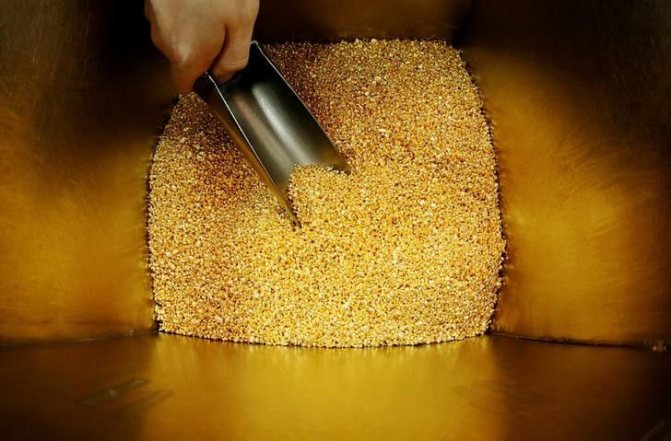
The Communist Party received considerable income from publishing. Literature was published in huge editions. The most minimal estimates indicate that monthly amounts amounting to hundreds of millions of rubles were received into the party treasury.
No less large sums of money were accumulated in the Peace Defense Fund. Ordinary citizens and the church made voluntary and forced contributions there. The fund was a non-profit organization, but was actually under the control of the same communist party. The Peace Fund did not publish any financial statements, but (according to rough estimates) its budget was 4.5 billion rubles.
Where did the gold go?
Where is the gold of the USSR? The search for the party fund was taken quite seriously. The existence of the Party's gold was more than just an urban legend or newspaper sensation. In the difficult conditions in which Russia found itself in 1991-1992 and beyond, there was an urgent need for party money.
The State Bank first published information on the amount of gold in 1991. It turned out that only 240 tons remained. This shocked Western experts, who estimated gold reserves from Soviet times at 1-3 thousand tons. But it turned out that even Venezuela has more valuable metal than the Land of the Soviets.
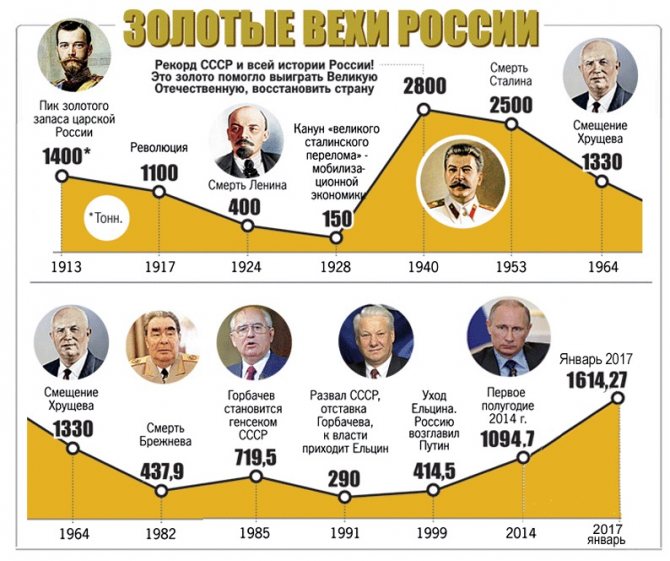
Miners from the Gulag
In 1931, to extract gold in the harsh conditions of the north, the Dalstroy trust was organized, which was responsible for the development of newly discovered gold deposits in Kolyma and Indigirka. According to geologists, up to 20% of the world's gold reserves were located in the valleys of these rivers. Already in 1931, a resolution of the Central Committee of the All-Union Communist Party of Bolsheviks obliged Dalstroy to extract two tons of gold, and by 1933 production should have been increased to 25 tons. Therefore, already on February 4, 1932, the first steamship Sakhalin arrived in Nagaev Bay in the Magadan Region, on board of which were the management of Dalstroy, specialists and security. The first prisoners were brought here. From 1932 to 1941 Dalstroy brought the treasury 400 tons of pure gold. Stalin did not care about the price. According to some estimates, Tsvetmet-Zoloto brought about another 800 tons. Soon the USSR became the leader in the extraction of precious metals, losing the lead only to South Africa. During the war, gold mining did not stop. The country paid them for supplies of food and weapons under Lend-Lease. Few people knew what the price of this gold was, and these were tens of thousands of ruined lives of “enemies of the people.” Immediately after the war, the sale of gold abroad was stopped, and the country began to accumulate reserves. Not only gold from the Far East flowed into the bins of the USSR, but also indemnities from the countries that lost the Second World War. Until Stalin's death, gold production in the Soviet Union did not fall below 100 thousand tons per year. By March 1953, the gold reserves of the Country of Soviets ranged from 2051 to 2804 tons.
Simple explanation
Immediately after the official publication of data on the size of gold reserves, rumors spread that the party treasury had been secretly taken to Switzerland. This process was, of course, led by the top leaders of the Communist Party. Subsequently, a very simple explanation was found for the depletion of the supply of valuable metal.
The fact is that in the last years of the USSR the government actively received loans secured by gold. The state was in dire need of currency, the flow of which was cut off due to a sharp drop in the price of oil and the collapse of the Council for Mutual Economic Assistance.
Versions of Western experts
The search for mysterious party gold was also carried out in the West. The government used the services of the world-famous Kroll agency. The organization's staff included former intelligence officers, accountants who worked in well-known companies, and other experts. The company was looking for money from Saddam Hussein, dictator Duvalier (Haiti) and Marcos (Philippines).
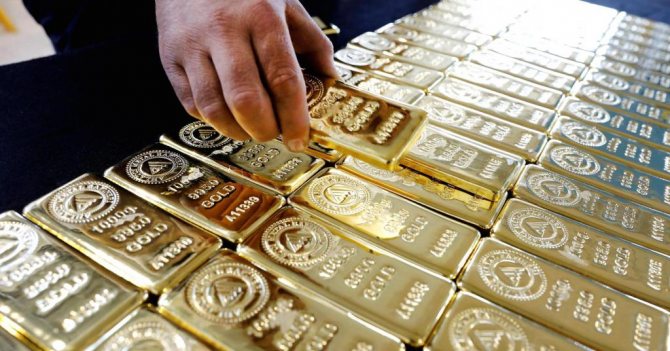
Soon after the conclusion of the agreement, the Americans sent the Russian government materials that included high-ranking government officials from the Soviet era, but there were no specifics. Russian leaders decided to refuse Kroll's services. This was motivated by the significant monetary costs of paying for the agency's services. The Russian treasury would not have been able to withstand such spending in difficult years.
So where is the money
It is obvious that the Communist Party had an impressive treasury and managed the money of some organizations. But where is the USSR money? It is unlikely that billions of rubles could have been transferred abroad, although some of the money could indeed have gone there.
The USSR had a sufficient number of banks abroad. Some were engaged in servicing foreign trade transactions, others operated as ordinary private banks. Branches were located in London, Paris, Singapore, Zurich and several other cities.
It was possible to withdraw money through these banks, but their employees were foreigners, so carrying out such operations was extremely risky. And it is these financial organizations that would be the first to be checked if they were seriously looking for the party’s money.
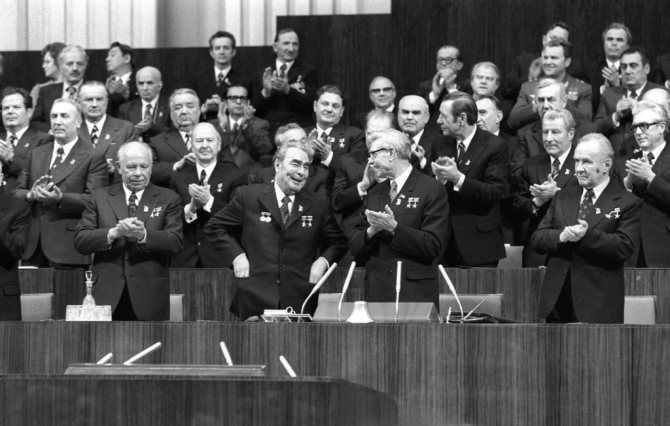
Plausible version
Most likely, the gold of the USSR remained in the USSR itself, that is, in circulation. The 1988 Cooperation Law allowed citizens to conduct commercial activities, but people did not have the initial capital for this. The Party paved the way by its example. The following year, the first private banks began to open. But where did the Soviet people get that kind of money? This is despite the fact that the authorized capital of the Soviet bank fund must have been at least 5 million rubles. Here, too, it could not have happened without the help of the Communist Party.
The main bonanza was, of course, international activity, which for a long time remained the monopoly of the CPSU. In the late eighties, private organizations entered this area. But foreign trade relations were supervised by the party and security forces. Rubles were exchanged at a reduced rate for foreign currency, and then inexpensive equipment was purchased with this money. Most often they imported computers, for which there was simply a huge demand.
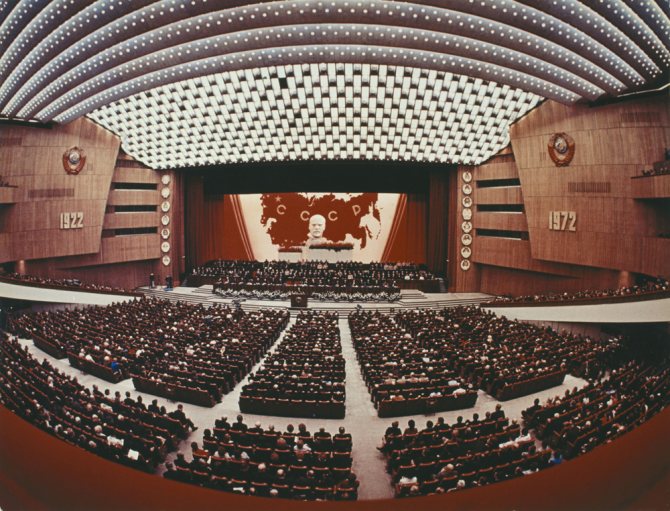
So, the party's gold really existed. But these are underground gold vaults or planes loaded to the brim with banknotes. Some of the money could have been pocketed by government and public figures, but it is unlikely that these were truly significant sums. Most of the money simply turned into paper in 1992. But the real gold was the leverage that allowed leaders to form capital for themselves in the last years of the USSR.
Soviet gold jewelry
In the 1990s, all “thinking intelligent people” began to criticize absolutely everything Soviet. They vilified the way of life of the Soviet people and almost all areas of life, including fashion, the beauty industry and jewelry. Fashion and cosmetics in the USSR were actually a sad spectacle, but with gold and silver jewelry everything was much better.
Even now, on the Internet you can find many publications ridiculing the quality and style of Soviet jewelry. But before condemning and ridiculing, we must remember that then there was a different fashion, different ideas about the beauty of jewelry and other possibilities. In Soviet times, many things were different, but the decorations were not so bad, and many of them are quite relevant in our time.

The design of most Soviet jewelry is inferior to the high-quality jewelry of our time, but foreign jewelry of those years is also different from modern jewelry, because jewelers acquired new technologies and equipment, and in addition, ideas about jewelry design have changed. It is important to note that Soviet jewelry is superior to many foreign products. This is easy to learn from old jewelers who had to deal with a wide variety of jewelry.
In addition to the quality of the products, many gold buyers are much more willing to buy scrap gold products of Soviet and Russian origin than Turkish and other jewelry, due to the difference in the ligature of the gold alloy.
Therefore, Soviet-era jewelry can be excellent accessories for those who like to experiment with looks and create looks using vintage items. Just don’t think that Soviet jewelry will soon become antique and be valued more than simple modern gold. There are still too many of these decorations, and only rarity is valued.
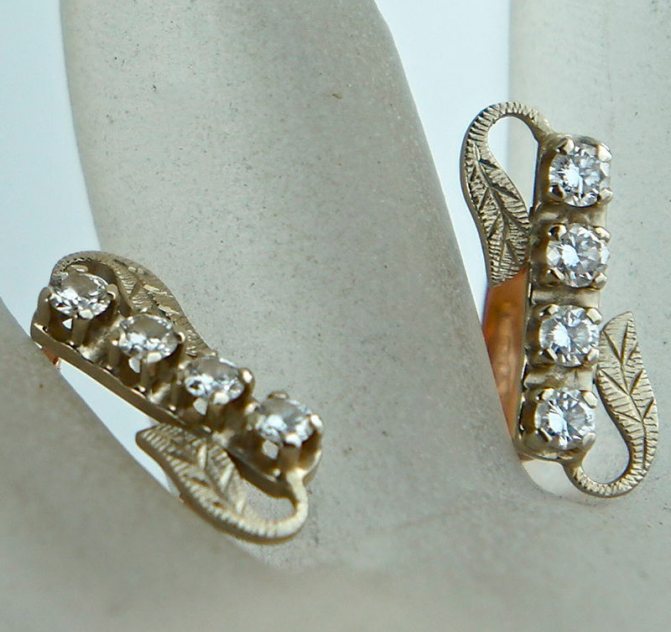
In the 1990s, ideas about jewelry changed. Signs of success began to be massive gold jewelry - heavy chains, watches with gold bracelets, signets and crosses. A huge number of thin chains, wedding rings and other jewelry from the Soviet and pre-revolutionary periods were melted down to create these products.
In addition to jewelry, orders were melted down. Most often, jewelers melted the Order of Lenin and the Order of the Patriotic War, 1st degree. These are not rumors and speculation, but reality. I personally know of jewelers who melted down dozens of orders in a month!
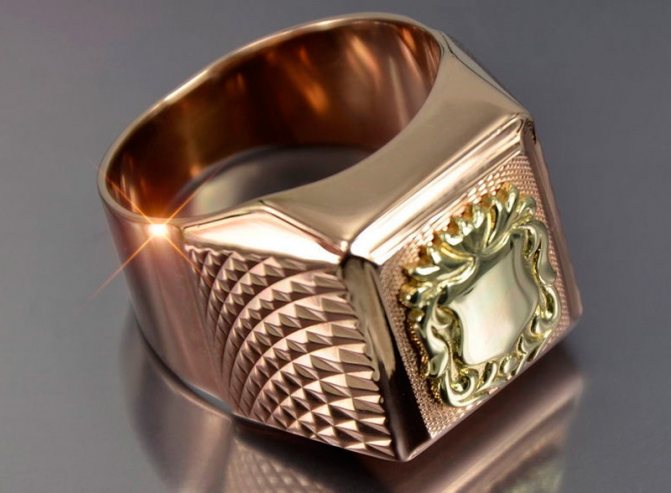
Over the years, massive jewelry has become a sign of bad taste. Today, few people would wear a thick gold chain and a huge spider signet; most of those cool kids from the 1990s now have marble and granite jewelry. Where did their gold chains and crosses go? Many items were melted down again by jewelers, and some are in safes and safe deposit boxes; other items remained in hiding places, waiting for their new owner.
Gold can change shape and wander from one owner to another for thousands of years. People turn to dust, and gold, changing shape, adorns the new owner or mistress.
Perhaps the ring on your finger was once melted down from a gold idol into medieval jewelry, and then went to the mint, where it was made into a coin, which was eventually punched into a hole and worn as a pendant. And already in the middle of the 20th century, the coin was scrapped and merged with other products, becoming your ring. It turns out that many of us carry pieces of ancient jewelry and coins on ourselves.
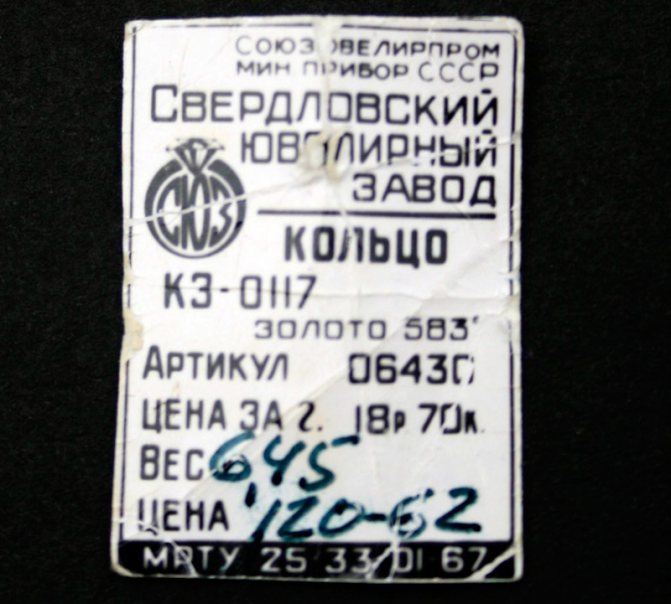
During the 1990s, a great deal of Soviet jewelry was melted down, but despite this there is still a lot left, so do not think that very soon they will become rare and begin to be valued as true antiques. This will not happen in our lifetime. Therefore, Soviet jewelry should be considered as vintage jewelry to create original images, and as a memory of the complex past of a great country.
All this does not apply to truly luxurious jewelry of the Soviet era, because even then real masterpieces of jewelry art were made, they were simply intended not for the common people, but for the elite, just like today. Luxury jewelry always finds its buyer, because they are rare, and rarity is much more valuable and, most likely, will never be found in the jewelry box of a common person.
